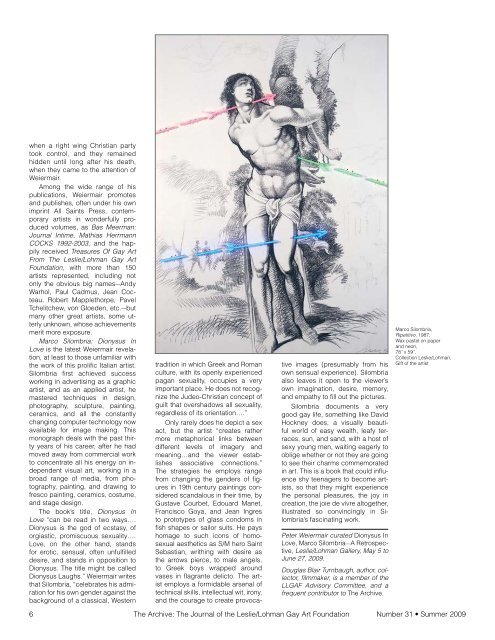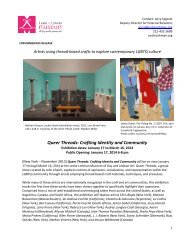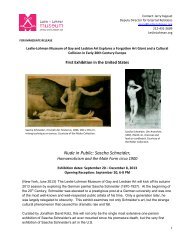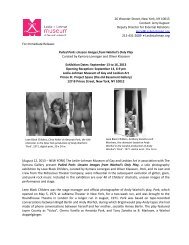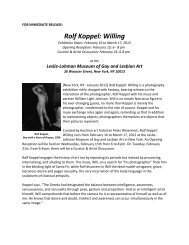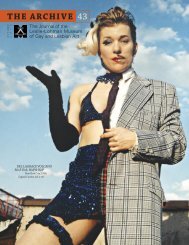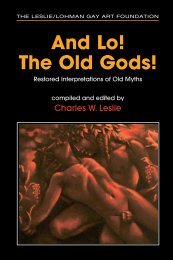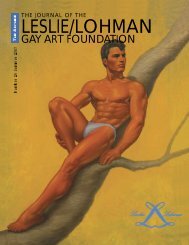B - Leslie-Lohman Gay Arts Foundation
B - Leslie-Lohman Gay Arts Foundation
B - Leslie-Lohman Gay Arts Foundation
You also want an ePaper? Increase the reach of your titles
YUMPU automatically turns print PDFs into web optimized ePapers that Google loves.
when a right wing Christian party<br />
took control, and they remained<br />
hidden until long after his death,<br />
when they came to the attention of<br />
Weiermair.<br />
Among the wide range of his<br />
publications, Weiermair promotes<br />
and publishes, often under his own<br />
imprint All Saints Press, contemporary<br />
artists in wonderfully produced<br />
volumes, as Bas Meerman:<br />
Journal Intime, Mathias Herrmann<br />
COCKS 1992-2003, and the happily<br />
received Treasures Of <strong>Gay</strong> Art<br />
From The <strong>Leslie</strong>/<strong>Lohman</strong> <strong>Gay</strong> Art<br />
<strong>Foundation</strong>, with more than 150<br />
artists represented, including not<br />
only the obvious big names—Andy<br />
Warhol, Paul Cadmus, Jean Cocteau,<br />
Robert Mapplethorpe, Pavel<br />
Tchelitchew, von Gloeden, etc.—but<br />
many other great artists, some utterly<br />
unknown, whose achievements<br />
merit more exposure.<br />
Marco Silombria: Dionysus In<br />
Love is the latest Weiermair revelation,<br />
at least to those unfamiliar with<br />
the work of this prolific Italian artist.<br />
Silombria first achieved success<br />
working in advertising as a graphic<br />
artist, and as an applied artist, he<br />
mastered techniques in design,<br />
photography, sculpture, painting,<br />
ceramics, and all the constantly<br />
changing computer technology now<br />
available for image making. This<br />
monograph deals with the past thirty<br />
years of his career, after he had<br />
moved away from commercial work<br />
to concentrate all his energy on independent<br />
visual art, working in a<br />
broad range of media, from photography,<br />
painting, and drawing to<br />
fresco painting, ceramics, costume,<br />
and stage design.<br />
The book’s title, Dionysus In<br />
Love “can be read in two ways….<br />
Dionysus is the god of ecstasy, of<br />
orgiastic, promiscuous sexuality….<br />
Love, on the other hand, stands<br />
for erotic, sensual, often unfulfilled<br />
desire, and stands in opposition to<br />
Dionysus. The title might be called<br />
Dionysus Laughs.” Weiermair writes<br />
that Silombria, “celebrates his admiration<br />
for his own gender against the<br />
background of a classical, Western<br />
tradition in which Greek and Roman<br />
culture, with its openly experienced<br />
pagan sexuality, occupies a very<br />
important place. He does not recognize<br />
the Judeo-Christian concept of<br />
guilt that overshadows all sexuality,<br />
regardless of its orientation….”<br />
Only rarely does he depict a sex<br />
act, but the artist “creates rather<br />
more metaphorical links between<br />
different levels of imagery and<br />
meaning…and the viewer establishes<br />
associative connections.”<br />
The strategies he employs range<br />
from changing the genders of figures<br />
in 19th century paintings considered<br />
scandalous in their time, by<br />
Gustave Courbet, Edouard Manet,<br />
Francisco Goya, and Jean Ingres<br />
to prototypes of glass condoms in<br />
fish shapes or sailor suits. He pays<br />
homage to such icons of homosexual<br />
aesthetics as S/M hero Saint<br />
Sebastian, writhing with desire as<br />
the arrows pierce, to male angels,<br />
to Greek boys wrapped around<br />
vases in flagrante delicto. The artist<br />
employs a formidable arsenal of<br />
technical skills, intellectual wit, irony,<br />
and the courage to create provoca-<br />
tive images (presumably from his<br />
own sensual experience). Silombria<br />
also leaves it open to the viewer’s<br />
own imagination, desire, memory,<br />
and empathy to fill out the pictures.<br />
Silombria documents a very<br />
good gay life, something like David<br />
Hockney does, a visually beautiful<br />
world of easy wealth, leafy terraces,<br />
sun, and sand, with a host of<br />
sexy young men, waiting eagerly to<br />
oblige whether or not they are going<br />
to see their charms commemorated<br />
in art. This is a book that could influence<br />
shy teenagers to become artists,<br />
so that they might experience<br />
the personal pleasures, the joy in<br />
creation, the joie de vivre altogether,<br />
illustrated so convincingly in Silombria’s<br />
fascinating work.<br />
Peter Weiermair curated Dionysus In<br />
Love, Marco Silombria—A Retrospective,<br />
<strong>Leslie</strong>/<strong>Lohman</strong> Gallery, May 5 to<br />
June 27, 2009.<br />
Douglas Blair Turnbaugh, author, collector,<br />
filmmaker, is a member of the<br />
LLGAF Advisory Committee, and a<br />
frequent contributor to The Archive.<br />
Marco Silombria,<br />
Ripetitivo, 1987,<br />
Wax pastel on paper<br />
and neon,<br />
78˝ x 59˝,<br />
Collection <strong>Leslie</strong>/<strong>Lohman</strong>,<br />
Gift of the artist<br />
6 The Archive: The Journal of the <strong>Leslie</strong>/<strong>Lohman</strong> <strong>Gay</strong> Art <strong>Foundation</strong> Number 31 • Summer 2009


